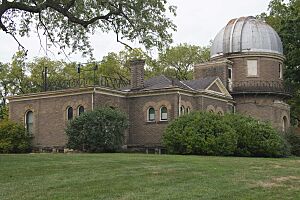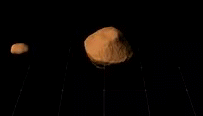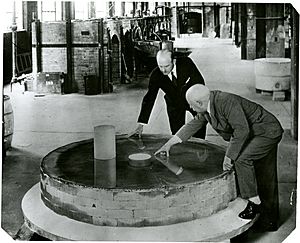Perkins Observatory facts for kids
The Perkins Observatory is a special place in Delaware, Ohio, where people can learn about astronomy and look at the stars. It's owned and run by Ohio Wesleyan University.
Back in 1931, this observatory had the third largest telescope in the world! It was called the 69-inch Perkins telescope. Its huge mirror was the biggest ever made in the United States at that time. It was created by the United States National Bureau of Standards.
In the 1930s, the observatory also started a magazine called The Telescope. It shared discoveries from the telescope and other cool astronomy news.
In 1935, the University teamed up with Ohio State University to help manage the big telescope. This partnership lasted for nearly 70 years! Later, in the 1960s, the telescope was moved to Arizona, USA, because the sky there was much clearer for viewing. It even got a new, bigger mirror. Even so, Perkins Observatory kept being a busy center for astronomy in Ohio and for the University.
Today, the Observatory hosts many public events and academic programs about space. It's also a great place to get information about things like NEO flybys (when asteroids pass close to Earth).
Contents
- Discovering the Past: Early History of Perkins Observatory
- Working with Ohio State University
- Challenges and Changes for Perkins Observatory
- A New Beginning: Rebirth and Reinvention
- Perkins Observatory Today
- Asteroid Flyby News
- Future Challenges for the Observatory
- The Famous 69-inch Perkins Telescope of 1931
- See also
Discovering the Past: Early History of Perkins Observatory
The observatory is named after Hiram Perkins. He was a professor of mathematics and astronomy at Ohio Wesleyan University from 1857 to 1907. Professor Perkins was a very religious and determined man. He was also known as a strict and demanding teacher.
Perkins believed that "The public should have a chance to see with a great telescope the objects such an instrument reveals." He thought this would help people "Learn to love God and serve Him more acceptably."
Perkins graduated from Ohio Wesleyan in 1857, just nine years after the university began. He was immediately offered a teaching job. Soon after, he married Caroline Barkdull, who also graduated from OWU's Women's College.
In 1861, Perkins left OWU for a short time when the American Civil War started. He wanted to join the Union Army, but he was too thin to serve. (He was 6 feet 4 inches tall but only weighed 97 pounds! His students even called him "the human skeleton.") Perkins then went back to his family's hog farm. He worked to help feed the soldiers, as Salt pork was a main food for the military back then.
He used his math skills to improve pork production. By the end of the war, he had earned a lot of money for that time. After the war, Perkins returned to his teaching job. He lived a very simple life on his small salary. Meanwhile, his smart business choices made his money grow a lot.
In 1896, Professor Perkins gave money to build the first observatory named after him. It's on West William Street in Delaware, Ohio, right next to where Hiram and Caroline used to live. This first "Perkins Astronomical Observatory" was later renamed "the Student Observatory" when the second Perkins Observatory was built about 25 years later.
Hiram and Caroline Perkins never had children. His older sister also never married. So, as he got older, Perkins realized he had no close family to leave his money to. After retiring in 1907, Professor Perkins focused on creating "an astronomical observatory of importance." He wanted this second observatory to be a place for important scientific research.
It took 15 years to find the right spot and get enough money. Perkins himself gave about $250,000, which would be like $3.8 million today! The total cost was about $350,000.
Construction started in 1923. The frail 90-year-old professor was the special guest at the groundbreaking ceremony. However, within a year, both Hiram and Caroline Perkins had passed away. Neither of them saw the new observatory finished.
The building has a copy of a famous artwork called "Apollo Watering the Horses of the Sun" above its front door. Around the building, there's a stone carving with the names of seventeen famous astronomers:
| Pythagoras | Aristarchus | Eratosthenes | Hipparchus |
| Ptolemy | Copernicus | Tycho Brahe | Galileo |
| Kepler | Newton | Laplace | Herschel |
| Fraunhofer | Huggins | Newcomb | Kapteyn |
| Barnard |
The building and the telescope's base were finished in less than two years. The Warner and Swasey Company from Cleveland, Ohio, did the work. This company also built other observatories and telescopes, like Yerkes Observatory near Chicago. The Perkins building included a lecture room, a library, offices, and even a small bedroom for visiting astronomers.
However, Professor Perkins had said that the telescope mirror had to be made in the United States. At that time, no U.S. companies had experience making such a huge mirror. So, the National Bureau of Standards agreed to do it. Some say that making this mirror helped start the optical glass industry in the United States.
The first four tries to make the mirror didn't work. The fifth try, using a different method, created a 69-inch (1.8 m) mirror blank. This was a bit bigger than planned. Then, it took three years of grinding and polishing. When it was finally put into the telescope mount in 1931, it was the third largest mirror in the world! Before this 69-inch mirror was installed, the observatory used a 60-inch (1.5 m) mirror borrowed from Harvard University.
Working with Ohio State University
It soon became clear that Ohio Wesleyan University didn't have enough staff or experts to run one of the world's most important observatories. So, in 1935, they made an agreement with Ohio State University in Columbus, Ohio. OSU would provide staff and help run Perkins Observatory. For the next 63 years, the observatory was mostly managed by OSU.
The next three decades were a great time for Perkins Observatory. The skies were dark, even if sometimes cloudy. Famous astronomers from all over the world came to central Ohio to use the large telescope. Important meetings for professional and amateur astronomers were held there. The library also grew to include many rare books.
Astronomer Philip C. Keenan spent most of his career working at Perkins Observatory. He was employed by Ohio State University. Using the 69-inch (1.8 m) telescope, he spent almost 20 years taking pictures of the night sky to study starlight. Working with William Wilson Morgan from Yerkes Observatory, Dr. Keenan helped create the M-K System of Stellar Classification. ("M" is for Morgan and "K" is for Keenan.) This is the most common way astronomers classify stars today.
In 1932, the Acting Director, Nikolai T. Bobrovnikov, started a small magazine called "The Telescope." At first, this magazine focused on research and news from Perkins Observatory. Later, it covered more astronomy topics. In 1941, it joined with another small astronomy magazine called "The Sky" to create "Sky & Telescope Magazine," which is still popular today!
Hiram Perkins's gift also said that the observatory should be open to the public at least once a month.
The famous radio telescope known as Big Ear was built on Perkins Observatory land. It operated from 1963 to 1998. Big Ear was well-known for its work on SETI (the search for alien life) and for detecting the mysterious WOW! Signal in 1977. This instrument was built and run by Ohio State University.
Challenges and Changes for Perkins Observatory
It turned out that central Ohio isn't the best place for a research telescope. The low elevation and often cloudy weather made it hard for astronomers to use the 69-inch (1.8 m) telescope. Also, the cities of Columbus and Delaware were growing. This meant more and more light pollution was making the sky brighter.
So, in 1961, the Perkins Telescope was moved to Lowell Observatory in Flagstaff, Arizona. Lowell is the largest private observatory in the world (not run by a university or government). For many years, the Perkins Telescope was Lowell's biggest instrument. Astronomers from Lowell and Ohio State University shared time using it.
The 69-inch (1.8 m) telescope at Perkins was quickly replaced with a 32-inch (810 mm) cassegrain reflector telescope. This telescope was given by Michael R. Schottland, a businessman from Virginia. At that time, it was the largest privately owned telescope in the United States. Today, it's still one of the three largest telescopes in Ohio.
In 1964, three years after the Perkins Telescope arrived at Lowell Observatory, its 69-inch (1.8 m) mirror was replaced. A new 72-inch (1.8 m) mirror, made of a more modern material, was put into the old telescope base. The original 69-inch (1.8 m) mirror was loaned to COSI in Columbus as an exhibit. (Eventually, the 69-inch mirror was returned to Perkins by 1999.)
Part of the agreement between OSU, OWU, and Lowell Observatory said that Ohio State would keep funding Perkins Observatory. This included taking care of the building, the library, and the monthly public programs. However, over the next few decades, without a main research telescope on site, interest in Perkins Observatory within the Ohio State University Astronomy Department decreased. The staff at the observatory got smaller, and there wasn't enough money to even keep up with astronomy magazine subscriptions for the library.
For some years, a smaller dome separate from the main building held a special Schmidt telescope. In 1990, this telescope was moved to Lowell Observatory and fixed up with money from NASA. In 1993, this new instrument became part of the LONEOS system, which helps find near-Earth asteroids. However, Perkins Observatory didn't get any money for its use.
Unfortunately, interest in Perkins Observatory also faded at Ohio Wesleyan University. Little attention was given to keeping up the historic property. An endowment fund of about $90,000 left by Hiram Perkins in his will (meant to pay for observatory operations and the Director's salary) somehow disappeared into OWU's general funds. Worst of all, most of the land around the observatory was sold to developers. From a large original plot, only 16 acres (65,000 m2) remained by 1990. (A golf course was built on the sold land, which later also took over the Big Ear radio telescope site.)
A New Beginning: Rebirth and Reinvention
In the 1990s, Tom Burns, a member of the Columbus Astronomical Society and an English professor at Ohio Wesleyan University, became the Director of Perkins Observatory. He greatly expanded the observatory's public programs and made it much more well-known in central Ohio.
A helpful partnership was also started with the Columbus Astronomical Society. In return for using the observatory for their monthly meetings and access to the telescopes, the Society provides volunteers to help with the many public programs.
Major repairs were made to the observatory dome. This was possible thanks to money earned from selling special glasses for the 1994 solar eclipse. Unused office and storage areas were turned into exhibit rooms, a children's play area, and a small gift shop. In September 1999, the original 69-inch (1.8 m) telescope mirror was brought back from COSI (where it had been stored in a closet for over ten years) and put on display.
In 1998, Ohio State University officially ended its partnership with Ohio Wesleyan University and Perkins Observatory. OSU pulled out of the 1935 agreement so it could use its money to buy time on the Large Binocular Telescope on Mount Graham. The 72-inch (1.8 m) telescope was sold directly to Lowell Observatory by Ohio Wesleyan University. The money from this sale went into the Perkins Observatory Endowment Fund. Staff members who used to be paid by Ohio State University started getting their paychecks from Ohio Wesleyan University.
Perkins Observatory Today
Today, regular stargazing programs are held almost every Friday and Saturday night throughout the year. Programs are also held on other evenings and during the day by special appointment. There's a monthly lecture series that covers different current topics in astronomy. Perkins also sponsors and organizes special events, like telescope fairs, guest speakers, and viewings of unusual astronomical events.
Thousands of people visited the observatory to see Comet Hale–Bopp in 1997. Each time a notable solar eclipse is visible from Central Ohio, several thousand pairs of eclipse glasses are given out, and educational school programs are scheduled. Famous astronomers like Ed Krupp, Director of Griffith Observatory, and John Dobson, who invented the Dobsonian telescope, have visited and given talks at Ohio Wesleyan University thanks to Perkins' support.
Perkins Observatory is now the most visible and reliable source of information about astronomy and space exploration in central Ohio. TV stations, newspapers, other local science museums, and the public rely on Professor Burns and his staff to answer questions, share information, appear in the media, and correct misunderstandings about space.
Asteroid Flyby News
In 2019, Perkins Observatory was noted for telling a local radio station about the flyby of the Near-Earth asteroid 1999 KW4 (also known as 66391 Moshup). They suggested viewing it with at least an 8-inch telescope. The asteroid was about 3 million miles away from Earth during its flyby. This asteroid won't return until 2036.
Future Challenges for the Observatory
Perkins Observatory faces many challenges as it enters the 21st Century.
Like many public places without government support, Perkins has limited funding. Even though Ohio Wesleyan University is very supportive, it can't provide all the money needed for staff, new programs, or maintaining the historic building. (An endowment fund has been set up, and donations are accepted.)
Since the observatory was built between 1923 and 1931, it has many maintenance issues common to old, historic buildings. Expensive repairs and heating/cooling costs use up a lot of the limited budget. Also, making the building easy for people with disabilities to access wasn't a concern in the 1920s. Updating the building for public use while keeping its unique look has been difficult, costly, and takes a lot of time.
The biggest problem Perkins Observatory faces now is the growing effect of light pollution. The city of Delaware is expanding from the north, and Columbus is expanding from the south. Even though there are lighting ordinances (rules about outdoor lights) in the area, making sure people follow them is a constant struggle. The observatory staff knows that a day will come when it will no longer be possible to see deep sky objects (faint galaxies and nebulae) from the site.
The observatory faced new challenges in October 2009 when part of the neighboring golf course planned to build large stores and apartments next to the observatory. This would certainly cause more light pollution and make observing even harder. Volunteers and staff are asking residents of Delaware and Columbus to share their opinions with the Delaware zoning commission to stop this from happening and protect the view of the heavens the observatory still has.
The Famous 69-inch Perkins Telescope of 1931
The 69-inch Perkins telescope was the 3rd largest telescope in the world when it started operating in 1931.
Here are some of the largest telescopes around the same time it was built:
| # | Name / Observatory |
Image | Size (Aperture) | Altitude | First Used |
Key Person | |
|---|---|---|---|---|---|---|---|
| 1 | Hooker Telescope Mount Wilson Obs. |
100 inch 254 cm |
1742 m (5715 ft) |
1917 | George Ellery Hale Andrew Carnegie |
||
| 2 | Plaskett telescope Dominion Astrophysical Obs. |
72 inch 182 cm |
230 m (755 ft) |
1918 | John S. Plaskett | ||
| 3 | 69-inch Perkins Telescope | 69 inch 175 cm |
1931 | Hiram Perkins |
In 1961, the telescope was moved away from Perkins Observatory. Eventually, the original 69-inch mirror was put in a museum. The 69-inch mirror was replaced with a new 72-inch mirror in the 1960s. That's why the telescope was later called the 72-inch Perkins, not the 69-inch.
The original 69-inch mirror was part of a telescope exhibit at one point. But then it was put in a closet and couldn't be seen. The mirror was returned to Perkins Observatory by 1999 and is now on display. This mirror was the first large mirror made in the United States. It was probably the third largest telescope mirror in the world when it started being used in 1931. The mirror blank weighed 3000 pounds and was made in 1927 by the United States Bureau of Standards. It needed 8 months to cool down properly!
The Perkins telescope, with its 72-inch mirror, was sold to Lowell Observatory in 1998. This improved version of the Perkins telescope is now located at Anderson Mesa in Arizona. It is used by Lowell Observatory and other universities for their research.
See also
 In Spanish: Observatorio Perkins para niños
In Spanish: Observatorio Perkins para niños




